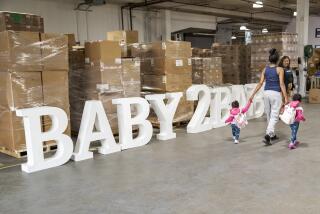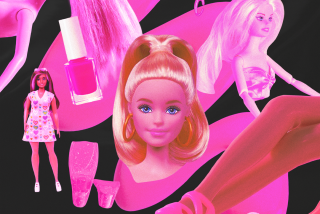Creature Comforts
With Beanie Babies multiplying like rabbits in households all over the country, it was only a matter of time before a cottage industry was born to help manage Beanie Baby collections.
Unless you’ve been living in a cave since they arrived on the scene four years ago, you know that Beanie Babies are those palm-sized, polyester beanbags with names such as Doodle the Rooster, Tank the Armadillo, Mystic the Unicorn and Nana the Monkey.
Manufacturer Ty Inc. declines to say how many Beanie Babies are out there--but it’s safe to bet it’s an enormous number. When McDonald’s ran a promotion last year featuring Teeny Beanie Babies, it unleashed 100 million of the critters on a hungry public.
So you’ve got tons of them taking up space. It turns out they shouldn’t be stored just anywhere--Beanie Babies have become too precious a commodity.
A coveted collection of the $5 stuffed animals, in mint condition with tags attached, can in some cases be sold to pay for Junior’s college tuition.
When it comes to protecting their cuddly investments, Beanie Baby gatherers of all ages say a plastic zipper bag, an old fish aquarium or a hanging wire fruit basket just won’t do.
“I used to have them in Baggies all over the place,” says 11-year-old Amy Rhodes of Garden Grove, who has 52 stuffed critters.
“I didn’t want them to get ruined, but I kinda felt sorry for them. They’re so cute, and in the Baggies they looked like I didn’t care about them or something.”
“You don’t want to just toss them in a corner somewhere,” says Mary Litner of the 148 Beanie Babies she has hunted down in gift shops and consumer shows during the past year or so. “Some of mine are worth a lot.”
At a recent charity auction in Dallas, bidding on a complete collection of Beanies began at $55,000--a frightening example of how precious these collections are.
At first, Litner used deep fruit bowls to store her critters. Finally, her Beanie Baby bowls simply runnethed over.
“Short of building something myself, I didn’t know what to do with them,” said Litner, 60, of Newport Beach. Her teenage son is building her something she hopes will be suitable, she says.
Seizing on the desperate need for Beanie Baby management, Debra Haynes and her husband, Steve, are marketing their own Beanie Baby acrylic display system: Beanie Baby Bungalows.
“I got my first Beanie Baby for my birthday two years ago,” says Haynes, whose 102-member collection quickly crowded a 6-foot shelf in her Costa Mesa living room--”I couldn’t see their little faces.”
Haynes sells the acrylic bungalows at consumer shows for $40 to $125 each.
And the market is heating up.
On the Internet, Beanie Web browsers can order the Bean Pole, the Beanie File and the Tree--all marketed in cyberspace as the perfect resting spot for the fuzzy beanbags.
The Container Store, retailer of storage and organization products, has also gotten into the Beanie Baby game. Collectors began telling clerks at the chain’s 19 locations--including one in Costa Mesa--about their storage problem, spokeswoman Casey Priest says.
The organizational demand has been huge, Priest says. Five types of display cases and toy hammocks are among the Container Store’s Beanie solutions.
Take the chain’s “little plastic box,” for instance--perfect for a single Beanie Baby. Originally sold without a specified use, it recently has been flying off the shelves, she says. In fact, there is a waiting list for the clear boxes: 14,170 of them are on back order.
“We’re selling about 400 a day,” she said.
Ty, a privately held company in Oak Brook, Ill., says that of the 146 characters produced to date, 45 are no longer being made.
Is Ty planning to get into the Beanie management market and make its own storage systems? Not at this time, according to spokeswoman Anne Nickels.
Meanwhile, in Fountain Valley, Sarah Kewes, 12, says that Beanie consolidation is of concern to her mother, but not to her. Sarah says she likes the hoard of “little guys” that threatens to spill off the oak toy chest in her bedroom.
“I like to rearrange them a lot,” she says. “But not being able to touch them? That’s no fun. . . . They’re supposed to be toys.”


